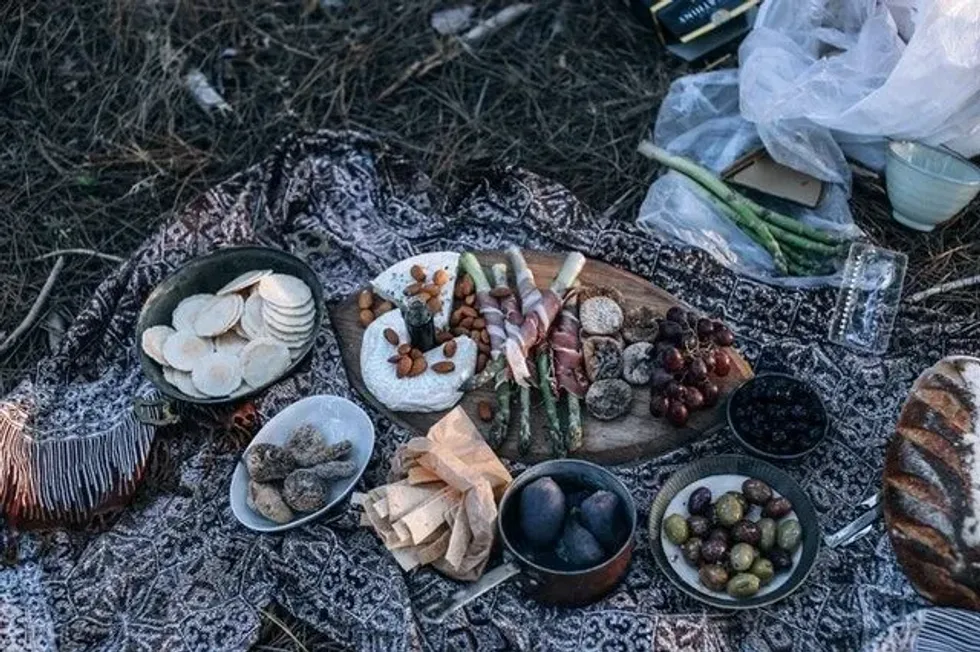Ancient Romans were passionate about power, exciting pleasures, and they also loved fine cuisine.
People in ancient Rome consumed a distinct variety of meals. It is said that a Roman ate based on his richness and region in the Roman Empire.
Ancient Romans ate three meals a day, much like us today. Their Breakfast, known as ientaculum, was traditionally served at sunrise.
The day's main meal was known as cena, served from noon to afternoon, and vesperna was a light supper at twilight. Sometimes cena would continue till late into the night and was generally followed by alcohol called comissatio.
As a result, vesperna gradually phased out over time, and Prandium, the midday meal, evolved before cena. However, these changes did not occur among the poor Romans since fixed routines related strictly to the daily rhythms of hard labor.
Wheat was the Romans' staple food. The main course, cena, basically consisted of porridge named puls.
Puls was made using hulled wheat, known as emmer, and adding water, salt, and fat. If feasible, it was cooked using olive oil and served with mixed vegetables.
Wealthy Romans puls had flat, circular loaves of emmer with a touch of salt along with eggs, cheese, honey, and milk and fruit, and it was further served with meat or fish on occasion.
It is noticed that white bread was traditionally cooked for the wealthy, with darker bread baked for the middle class and the darkest bread baked for poor Romans.
The ancient Roman diet included green olives, pear, figs, and various vegetables. Roman people ate meat but valued mostly seafood and poultry, which led to the development of oyster farming, snail farming, and oak grub farming.
Romans ate various legumes, such as dried peas and fava beans, and nuts such as walnuts, almonds, pine nuts, and sesame seeds. The key ingredient in the majority of the foods consumed was cheese. As Roman emperors recommended olive tree plantations and olive oil manufacturing, olive oil became more extensive in Roman kitchens.
Don't forget to check our related articles to discover more about Romans, like Ancient Roman clothes facts and Ancient Rome architecture facts.
Which was the most popular dish in ancient Rome?
If you relish experiencing Roman food, you'll notice that it's often sweet and sour. They usually add fruits and honey to their meals for a sweet flavor and vinegar for a sour flavor, giving it a sweet and sour flavor. Let's have a peek at some of their most popular dishes.
The most popular ancient Roman food mainly consisted of Garum, a fermented fish sauce traditionally poured into meals after cooking to impart a specific taste or improve the flavor. Garum was also used as a medication. It was regarded as one of the finest remedies for various diseases, including dog bites, ulcers, relieving chronic diarrhea, and treating constipation.
Bruschetta is a traditional first course of ancient Rome, which has grilled bread made with garlic and salt coated with olive oil. A variety of toppings such as tomato, beans, vegetables, pork, or cheese can also be added.
It is made using a unique grill called the brustolina grill in ancient Rome. When olive producers went to a market holding green olives for the oil press, they enjoyed the taste of their newly squeezed oil with this piece of bread.
Carciofi Alla Romana is a classic Roman dish that means ' Roman-style artichokes'' From ancient times to the present day in Rome, it is made in every household and served as a special meal during the spring season.
Trippa Alla Romana is another famous dish of ancient Roman cuisine. It is a form of cuisine that arose from poor, rural households as part of Quinto quarto, meaning 'the fifth quarter,' or the offal of butchered animals after the elite took the first four portions.
This meal is made with tripe from beef, pork, and sheep, white onions, carrots, skinned tomatoes, Pecorino Romano cheese, pennyroyal leaves, and white wine.
Hardtack, also known as Bucellatum in Roman script, is a simple cookie consisting of wheat, water, and salt. Hardtack is a low-cost, long-lasting cracker cooked twice at a low temperature for a long time to guarantee no moisture left inside.
The lack of perishable foods is used as the main meal during prolonged voyages and military conflicts. It was also a more prevalent food supply in ancient Greece as a substitute for a three-course meal.
What weird food did ancient Romans eat?
Not all Roman food is impressive, and you might be surprised to find that the Romans ate some unusual foods. Let's have a look at what Roman kitchens have.
In ancient Rome, they ate dormouse, which was regarded as a delicacy, either as a savory appetizer or dessert. They were served piping hot coated in honey and rolled in poppy seed.
Serving Dormice was treated as a status symbol. The Romans had a special terracotta enclosure called glirarium to raise these dormice for supper, which were also weighed in front of dinner guests to impress them.
The Roman diet includes a wide range of birds, including peacocks, parrots, and pigeons. Of all, you'd be surprised to learn that Romans relished eating flamingo tongue.
Yes, you read it correctly; they believe the flamingo's tongue has an unusually fine taste. It doesn't appear to be especially pleasant to us, but flamingos were regarded as a status symbol of luxury and class in Roman times. Hence, it's no surprise that upper-class Romans loved them and were the highlight of any lavish dinner.
Traditional Roman food includes lamb brains, which were frequently stuffed into sausages and other meat dishes. One unique recipe is served with eggs, pepper, and, notably, rose petals.
What did rich Romans eat?

Rich Romans ate various meals because they could afford to spend a lot of money on food and drink. Let's have a look at how they differ from another main course.
They routinely threw dinner parties, which were expensive affairs with plenty of exotic food and wine. Roman meals include large platters of the most exotic fruits, which could not be grown in Rome, were brought in from other continents for the rich.
They even seasoned and cooked meat with unique Indian exotic spices like cinnamon, clove, pepper, and nutmeg.
In addition, only wealthy Romans could afford wild boar, pigs, lamb, camel, duck, geese, chickens, parrots, ostrich, giraffe, and fish.
Roasting a rabbit with wings arranged on it to make it appear like a flying horse was a popular way for Romans to enjoy lunch. A lavish Roman dinner may contain not just a variety of vegetables, nuts, wild fruits, wild game meat, and fish but also snails and shellfish.
The meat was more costly in ancient Rome than now. While ordinary Romans could not afford to eat meat, the privileged did. Peacock was a favorite choice, and it is served roasted or lay small sausages. Peacock eggs were also extremely popular in Roman society.
Wine was an essential element and main drink; it is an integral part of the dinner parties for most Romans, and several recipes included wine. Conditum Paradoxum is a recipe for a prepared and preserved blend of wine, honey, laurel, pepper, mastic, dates, and saffron.
Do you know these lavish dinner parties were held in the triclinium, ancient dining room? These dinner parties might run up to eight hours. However, Romans did not sit around the table on chairs as we do now.
They sat on slanted sofas arranged around a square table. Only little children or slaves were allowed to eat while sitting. Some people even maintained another smaller dining room for less important meals and family meals.
Ancient Roman Food Recipes
If you love to experience Roman life with ancient cuisine cooked with basic ingredients, you may have some at home right now? Try some of the following recipes:
Ova spongia ex lacte: For this, you require four eggs, 1 cup (250 ml) milk, one tablespoon olive oil, three tablespoons of honey, and a pinch of black pepper powder.
You need to beat the eggs thoroughly, then mix them with the milk and olive oil. In a heated pan, add some olive oil and a scoop of the egg mixture. Cook the mixture without rotating them till done. Now your ova spongia ex lacte is ready, serve along with the honey and sprinkled ground pepper.
Athenian Cabbage: Let's see how to make this tasty appetizer. All you need is one small white cabbage, two tablespoons chopped fresh green coriander, two tablespoons chopped fresh or dried rue, 1/2 cup (120gm) honey, two tablespoons red wine vinegar, asafoetida powder, and salt.
To begin, we need to make honey vinegar sauce. Boil honey, skim it, and add the vinegar and reduce it slightly. Now finely slice the washed cabbage. Toss the cabbage in a pan with the coriander and rue, now add three tablespoons of honey vinegar, then season with asafoetida powder and a teaspoon of salt.
It is a familiar recipe among Greek and Roman authors. It is claimed to cure headaches and gastric troubles. It is stated that if eaten before a meal, it reduces intoxication and that if taken after drinking, it can heal a hangover!
Here at Kidadl, we have carefully created lots of interesting family-friendly facts for everyone to enjoy! If you liked our suggestions for Ancient Roman food facts, then why not take a look at Ancient Roman government facts or Ancient Roman religion facts.










